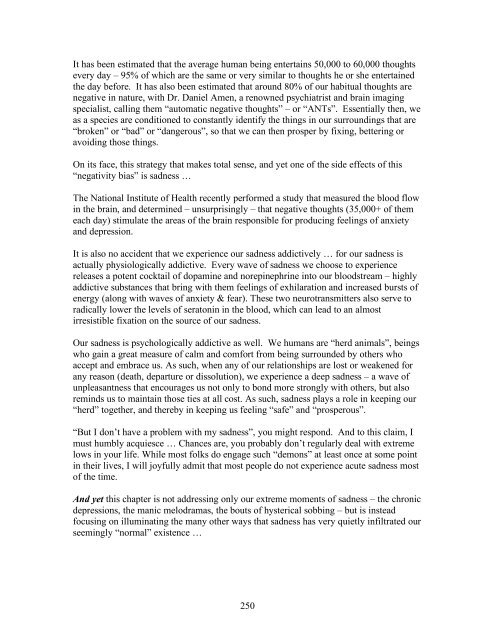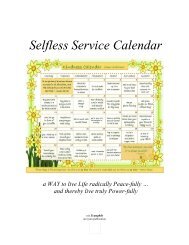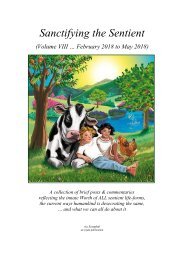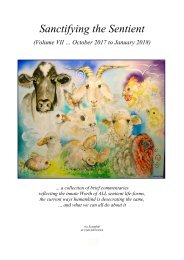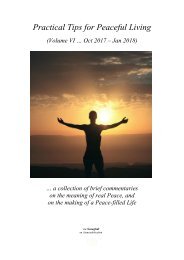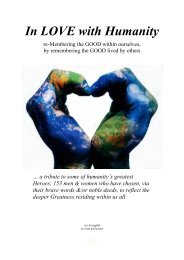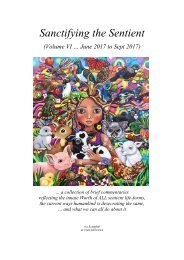Licking the Razor's Edge (2015)
Recognizing the hidden addictions that bind you, … to then set your True Self free
Recognizing the hidden addictions that bind you,
… to then set your True Self free
Create successful ePaper yourself
Turn your PDF publications into a flip-book with our unique Google optimized e-Paper software.
It has been estimated that <strong>the</strong> average human being entertains 50,000 to 60,000 thoughts<br />
every day – 95% of which are <strong>the</strong> same or very similar to thoughts he or she entertained<br />
<strong>the</strong> day before. It has also been estimated that around 80% of our habitual thoughts are<br />
negative in nature, with Dr. Daniel Amen, a renowned psychiatrist and brain imaging<br />
specialist, calling <strong>the</strong>m “automatic negative thoughts” – or “ANTs”. Essentially <strong>the</strong>n, we<br />
as a species are conditioned to constantly identify <strong>the</strong> things in our surroundings that are<br />
“broken” or “bad” or “dangerous”, so that we can <strong>the</strong>n prosper by fixing, bettering or<br />
avoiding those things.<br />
On its face, this strategy that makes total sense, and yet one of <strong>the</strong> side effects of this<br />
“negativity bias” is sadness …<br />
The National Institute of Health recently performed a study that measured <strong>the</strong> blood flow<br />
in <strong>the</strong> brain, and determined – unsurprisingly – that negative thoughts (35,000+ of <strong>the</strong>m<br />
each day) stimulate <strong>the</strong> areas of <strong>the</strong> brain responsible for producing feelings of anxiety<br />
and depression.<br />
It is also no accident that we experience our sadness addictively … for our sadness is<br />
actually physiologically addictive. Every wave of sadness we choose to experience<br />
releases a potent cocktail of dopamine and norepinephrine into our bloodstream – highly<br />
addictive substances that bring with <strong>the</strong>m feelings of exhilaration and increased bursts of<br />
energy (along with waves of anxiety & fear). These two neurotransmitters also serve to<br />
radically lower <strong>the</strong> levels of seratonin in <strong>the</strong> blood, which can lead to an almost<br />
irresistible fixation on <strong>the</strong> source of our sadness.<br />
Our sadness is psychologically addictive as well. We humans are “herd animals”, beings<br />
who gain a great measure of calm and comfort from being surrounded by o<strong>the</strong>rs who<br />
accept and embrace us. As such, when any of our relationships are lost or weakened for<br />
any reason (death, departure or dissolution), we experience a deep sadness – a wave of<br />
unpleasantness that encourages us not only to bond more strongly with o<strong>the</strong>rs, but also<br />
reminds us to maintain those ties at all cost. As such, sadness plays a role in keeping our<br />
“herd” toge<strong>the</strong>r, and <strong>the</strong>reby in keeping us feeling “safe” and “prosperous”.<br />
“But I don’t have a problem with my sadness”, you might respond. And to this claim, I<br />
must humbly acquiesce … Chances are, you probably don’t regularly deal with extreme<br />
lows in your life. While most folks do engage such “demons” at least once at some point<br />
in <strong>the</strong>ir lives, I will joyfully admit that most people do not experience acute sadness most<br />
of <strong>the</strong> time.<br />
And yet this chapter is not addressing only our extreme moments of sadness – <strong>the</strong> chronic<br />
depressions, <strong>the</strong> manic melodramas, <strong>the</strong> bouts of hysterical sobbing – but is instead<br />
focusing on illuminating <strong>the</strong> many o<strong>the</strong>r ways that sadness has very quietly infiltrated our<br />
seemingly “normal” existence …<br />
250


